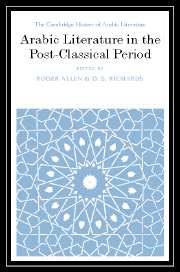Book contents
- Frontmatter
- The post-classical period: parameters and preliminaries
- Part I Elite Poetry
- Part II Elite prose
- Part III Popular poetry
- Part IV Popular prose
- 11 Popular prose in the post-classical period
- 12 A Thousand and One Nights: a history of the text and its reception
- 13 Sīrat‘ Antar ibn Shaddād
- 14 Sīrat Banī Hilāl
- 15 Other sīras and popular narratives
- 16 Popular religious narratives
- Part V Drama
- Part VI Criticism
- Bibliography
- Index
- References
11 - Popular prose in the post-classical period
from Part IV - Popular prose
Published online by Cambridge University Press: 28 March 2008
- Frontmatter
- The post-classical period: parameters and preliminaries
- Part I Elite Poetry
- Part II Elite prose
- Part III Popular poetry
- Part IV Popular prose
- 11 Popular prose in the post-classical period
- 12 A Thousand and One Nights: a history of the text and its reception
- 13 Sīrat‘ Antar ibn Shaddād
- 14 Sīrat Banī Hilāl
- 15 Other sīras and popular narratives
- 16 Popular religious narratives
- Part V Drama
- Part VI Criticism
- Bibliography
- Index
- References
Summary
In Europe, the rise of popular literature is usually linked to the advent of print. The drastically reduced cost of producing texts on the printing press is understood to have sparked the emergence of new literary forms (such as the broadsheet, penny ballad, popular romance and novel) that were composed, produced and marketed to be read by- or read to - a growing public of literate and partially literate consumers. These new literary forms, the means of their production and the patterns of their consumption are considered to be distinct from those of both oral folk traditions that circulated in live performances and from the literary creations of ‘high’ or ‘elite’ culture, even when strong similarities existed among them. Although European popular literature eventually generated forms and styles of its own, it also drew constantly on both folklore and elite literature for materials and stylistic inspiration. Due to this hybrid or syncretic nature, wherever ‘popular’ has been used as an analytical category in contrast to ‘elite’ and ‘folk’, it has almost invariably been the least well defined of the three.
In the Arab world the impact of the printing press was not widely felt until the nineteenth century, but a domain that may be appropriately analysed as ‘popular literature’ (adab ‘āmmī) had by that time already existed for nearly a millennium. The technological context for the growth of popular literature had already emerged in the mid-eighth century with the introduction of paper-making. Although paper had been imported from China for sometime previously, it was the transplantation of paper-making as an industry that opened the doors for a new ‘book culture’ and led to the rise of a new class of authors, scribes, copyists, paper-vendors and booksellers.
- Type
- Chapter
- Information
- Arabic Literature in the Post-Classical Period , pp. 243 - 269Publisher: Cambridge University PressPrint publication year: 2006
References
- 1
- Cited by



